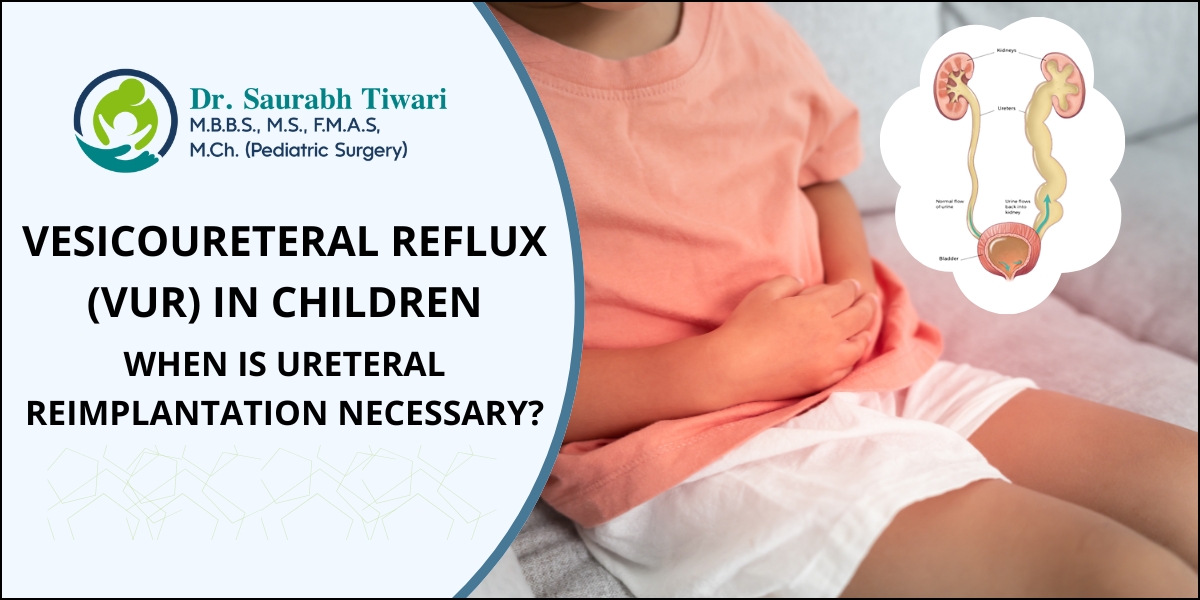A diagnosis of Vesicoureteral Reflux (VUR) in your child can be worrying for any parent. VUR is a condition where urine flows backward from the bladder up into the ureters and sometimes even to the kidneys. This reverse flow can increase the risk of kidney infections and potential long-term damage. While many children outgrow mild forms of VUR, some require intervention. One of the most effective and definitive surgical treatments is ureteral reimplantation.
Understanding the Goals of VUR Treatment
The primary goals are always to:
-
Prevent kidney infections.
-
Protect the kidneys from scarring and long-term damage.
-
Resolve the reflux itself.
Treatment often starts conservatively with daily low-dose antibiotics (prophylactic antibiotics) to prevent infections while waiting for the child to outgrow the condition. Regular monitoring with ultrasounds and scans is crucial.
When is Ureteral Reimplantation Recommended?
Ureteral reimplantation is a surgical procedure that repositionsthe ureters into the bladder wall to create a valve mechanism that prevents urine from flowing backward. It is typically considered in the following scenarios:
-
High-Grade Reflux (Grade IV-V): Children with severe reflux are less likely to outgrow it spontaneously and are at a higher risk for kidney damage. Surgery is often recommended early on.
-
Breakthrough Febrile UTIs: If a child continues to get high-grade fevers and kidney infections despite being on preventive antibiotics, it indicates the conservative method is failing.
-
Poor Compliance with Medication: Difficulty in consistently administering daily antibiotics can leave the child vulnerable to infections, making surgery a more reliable option.
-
Renal Scarring: Evidence of new or worsening kidney scarring on a DMSA scan is a major red flag, prompting the need for a definitive solution.
-
Older Age at Diagnosis: The chances of outgrowing VUR decrease as a child gets older. If significant reflux persists beyond age 5-7, surgery is frequently advised.
-
Anatomical Abnormalities: Issues like a diverticulum (a pouch) near the ureter’s entrance or a duplex system (two ureters from one kidney) often require surgical correction.
The Procedure and Recovery
Ureteral reimplantation is highly successful, with a cure rate of over 95%. Performed under general anesthesia, it involves making a small incision in the lower abdomen. Most children stay in the hospital for a few days and can return to normal activities within 2-4 weeks. Modern techniques, including minimally invasive options, have made recovery faster and less painful.
Making the Decision
The decision to proceed with surgery is made collaboratively between the parents and the pediatric urologist or surgeon. It is based on a careful assessment of the child’s specific grade of reflux, history of infections, kidney function, and overall health.
If your child has been diagnosed with VUR, consulting with an experienced pediatric urologist is vital. Consult specialists like Dr. Saurabh Tiwari, a renowned Pediatric Surgeon in Mumbai, can guide you through the options and recommend the best, most personalized treatment plan to ensure your child’s long-term kidney health.
Frequently Asked Questions (FAQs)
1. Can a child outgrow VUR?
Yes, many children, especially those with Grade I-III reflux, outgrow it as the ureter lengthens and matures with age. This is often managed with watchful waiting and preventive antibiotics.
2. What is the success rate of ureteral reimplantation?
Ureteral reimplantation has a very high success rate, exceeding 95% for curing vesicoureteral reflux.
3. Are there alternatives to open surgery for VUR?
Yes, a minimally invasive alternative called Deflux® (endoscopic injection) is available. It involves injecting a gel-like substance to correct the reflux but may have a lower long-term success rate than reimplantation for higher grades.
4. What are the signs of a kidney infection in a child?
Key signs include a high fever, chills, pain in the back or side, vomiting, fussiness, and strong-smelling or cloudy urine.
5. How is VUR diagnosed?
It is typically diagnosed after a child has a UTI. A test called a Voiding Cystourethrogram (VCUG), where contrast dye is used to fill the bladder and X-rays are taken, is the gold standard for diagnosing and grading VUR.




